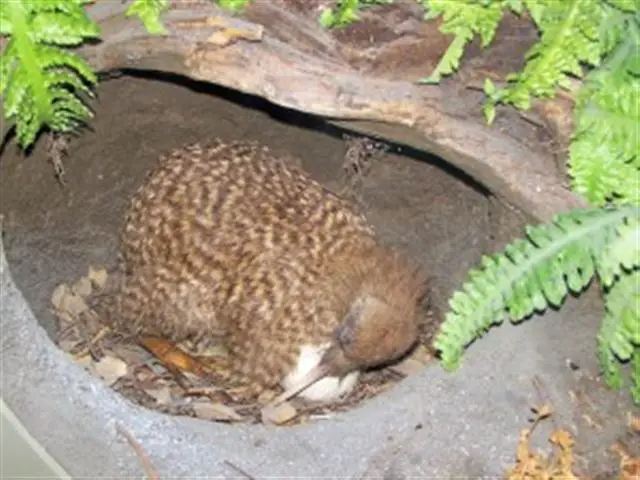This article lays down some of the most amazing and interesting kiwi bird facts that you may want to share with your kids. Kiwi bird is a flightless bird found in New Zealand. It is the smallest member of the group of all the flightless running birds of which ostrich and emu are the largest flightless birds. It is named after its characteristic sound or shrill cry ‘kee-wee kee-wee’ usually produced by the male kiwis. Its natural habitat is found in New Zealand (North and South Islands and Stewart Island) and now I think you may have figured out why the people of New Zealand call themselves Kiwis!
Kiwi Bird Facts
- The most prominent feature of kiwi bird is that it is both tailless and wingless bird.
- Its entire body is covered with brownish grey down feathers.
- The body of a male kiwi is approximately 45 cm long whereas the bodies of female kiwi are bigger than male maximum up to 54 cm.
- Kiwi has a characteristic long beak about 1/3 of its body length that is used by it to find food by dipping it repetitively into leaf litters in search of food.
- Kiwi is a flightless bird because of its unnoticeable short wings that are only 5cm in length and are hidden under its feathers.
- Kiwi has strong and powerful legs with claws that help them in digging its burrow.
- Being a nocturnal (animals that comes out at night), it feeds on continuously only at night.
- It eyes are small and unique with weak eyesight.
- It has a strong sense of smell owing to its nostrils that are present at the end of its beak. This remarkable sense of smell assists it to search food even in the dark night.
- Their average life span is about 20 to 30 years.
 Kiwi Bird Habitat Facts
Kiwi Bird Habitat Facts
This bird does not show nest building behavior and resides in forests, woods and plains deep inside in their burrows. Its main diet consists of earthworms, insects, larvae, beetles, snails, crayfish and fruits.
Kiwi Bird Egg Facts
It lays huge eggs in a burrow from July to February. The size of the egg is larger as compared to size of their body. During the course of gestation, the female kiwi feeds three times more than normal and the size of her belly becomes so huge that it touches the ground. The male kiwi incubates the egg and guard it until it has hatched. A very important fact about its egg is that it contains more yolk as compared to the other birds’ egg.
 Species of Kiwi
Species of Kiwi
There five important species of this bird named as:
- Brown kiwi
- Great spotted kiwi
- Rowi
- Lesser spotted kiwi
- Tokoeka
Interesting Kiwi Bird Facts
Though classified as a bird, yet kiwis have some characteristics similar to that of mammals, which make them unique:
- Their bodies are covered with a thick shaggy like fur that looks more like hair rather than feathers.
- Their skin is very tough and hard similar to that of mammals and is difficult to penetrate.
- The bones of kiwi are heavy like mammals rather than light and porous as that of birds.
- The claws of kiwi have much resemblance to that of cat rather than that of birds.
- The temperature of kiwi’s body is around 38° C, which is marginally higher than humans and lower than other birds
Support the Kiwi
It was a brief introduction about this unique bird. We have gathered down some great kiwi bird pictures from the internet. Kiwi has been here on this earth for millions of years but rapid urbanization in New Zealand have deprived them their natural habitat. Moreover, the introduction of predators like dogs has hastened its declining population. This unique bird is at the verge of extinction and we should support all those programs that have taken the initiative to protect them.

Leave a Reply